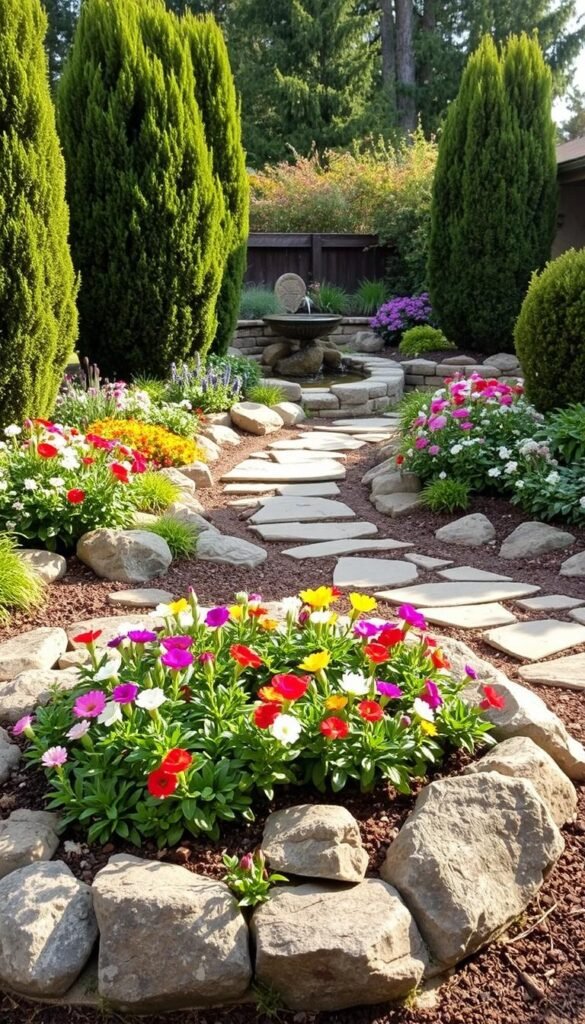Your home’s exterior sets the tone for what’s inside. A well-designed outdoor area blends natural beauty with practical design. Imagine colorful blooms framed by stone pathways or decorative borders that guide the eye. This balance creates lasting curb appeal while making your property feel welcoming.
Even small spaces can shine with thoughtful planning. Raised beds or bordered planters add structure to flower displays, while materials like gravel or pavers keep the design low-maintenance. The goal? A cohesive look that thrives in every season.
You don’t need a massive budget to make an impact. Simple upgrades—like mixing perennials with evergreen shrubs—ensure year-round interest. Pair these with functional elements: a retaining wall for sloped areas or a bench nestled among blossoms. These touches turn ordinary lawns into destination spots for relaxation.
Ready to rethink your outdoor space? We’ll explore how to choose plants suited to your climate and hardscaping materials that complement your home’s style. Let’s create a front yard that feels both timeless and uniquely yours.
Embracing Hardscaping to Enhance Your Outdoor Space
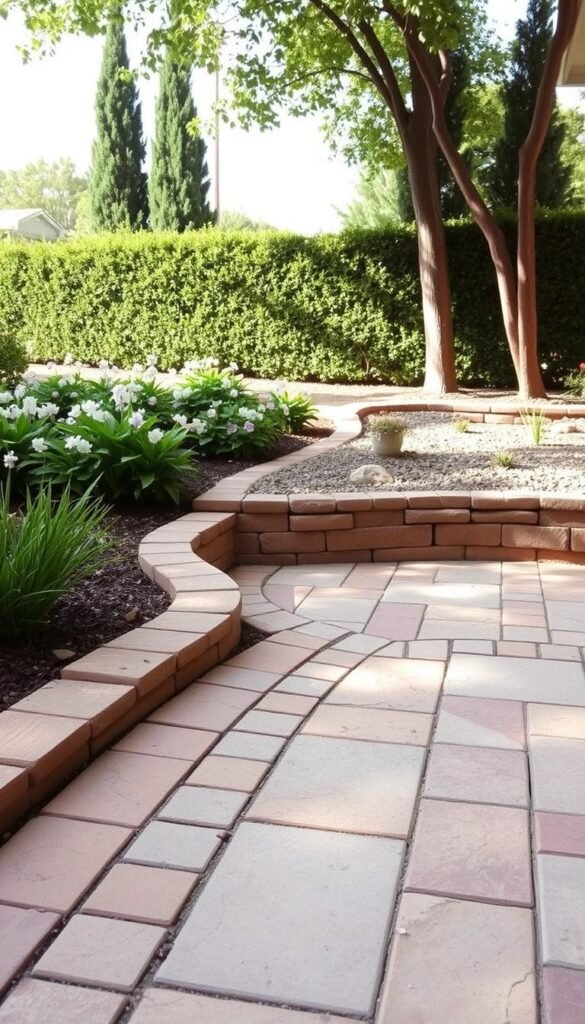
Integrating hardscaping elements can redefine the functionality of your yard. These permanent features add structure and stability to your landscaping while cutting down on weekly chores. Think of them as the framework that lets your flowers shine without constant upkeep.
Benefits and Durability
Stone pathways and brick borders aren’t just pretty—they’re practical. Unlike plants needing daily care, these materials withstand rain, snow, and foot traffic. One homeowner noted: “Our gravel patio still looks sharp after five winters, and we never touch a rake!”
Here’s how popular options compare:
| Material | Best Use | Maintenance Level |
|---|---|---|
| Natural Stone | Pathways & Retaining Walls | Low |
| Concrete Pavers | Patios & Borders | Moderate |
| Recycled Brick | Edging & Accents | Minimal |
Design Flexibility for Modern Yards
Whether your style leans modern or rustic, hardscaping adapts. Clean-lined concrete planters suit urban spaces, while flagstone steps blend into cottage gardens. For creative gardening ideas, mix materials like wood and stone to add texture.
Sloped yard? Terraced walls create flat planting areas. Narrow space? A winding path makes it feel larger. These solutions solve problems while boosting curb appeal—no green thumb required.
Discover Inspiring Front Yard Flower Bed Ideas
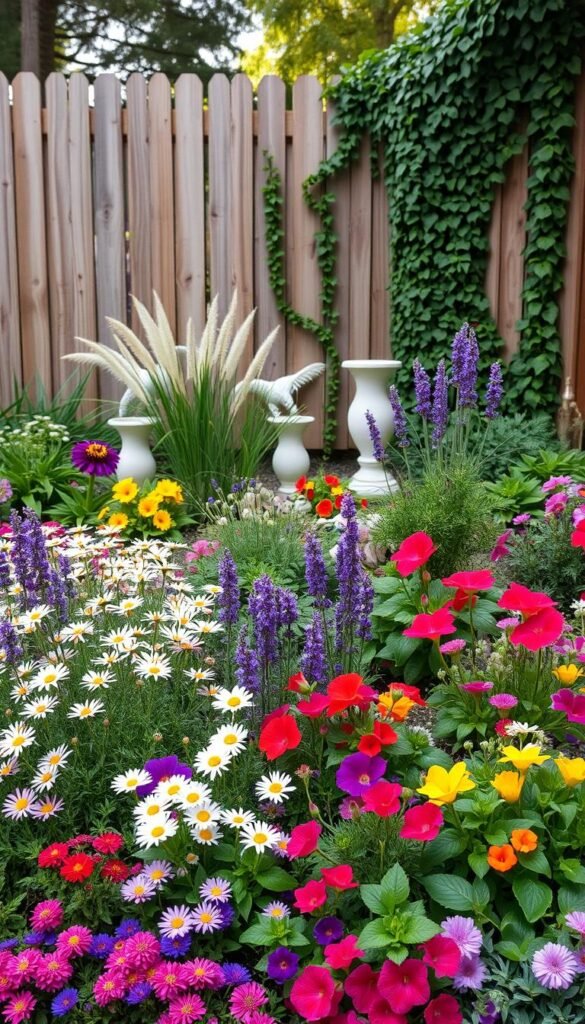
A well-planned floral arrangement turns ordinary soil into a canvas of seasonal beauty. Start by considering layouts that guide the eye while supporting plant health.
Creative Flower Bed Layouts
Layering plants by height creates depth and ensures every flower gets sunlight. Try tall foxgloves or sunflowers at the back, mid-sized coneflowers in the center, and creeping thyme up front. One gardener shared: “Grouping plants this way made my narrow space feel lush without overcrowding.”
Circular designs work wonders for breaking up square lawns. Place a birdbath or ornamental grass cluster in the center, then surround it with staggered blooms. For structured charm, border gardens along walkways blend functionality with aesthetics.
| Style | Key Features | Best Plants |
|---|---|---|
| Cottage Garden | Mixed heights, informal | Lavender, peonies, daisies |
| Pollinator Focus | Native species clusters | Milkweed, salvia, bee balm |
| Modern Minimalist | Geometric shapes | Ornamental grasses, alliums |
Integrating Color and Texture
Plan for color rotation: tulips in spring, black-eyed Susans in summer, and chrysanthemums in fall. Pair velvety lamb’s ear with spiky yucca leaves for tactile contrast. This approach keeps beds lively even when fewer plants bloom.
Remember: texture isn’t just visual. Fuzzy stalks, glossy leaves, and feathery grasses add dimension you can almost feel. Combine these elements to make your flower beds pop from every angle.
Planning Your Layout and Design Strategy
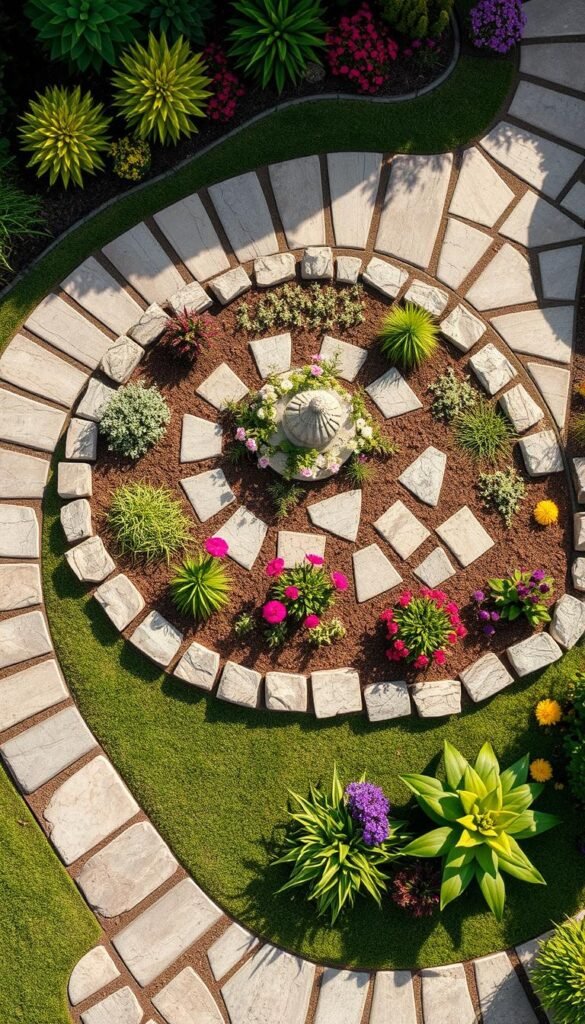
A successful outdoor transformation starts with smart planning. Think of your yard as a blank canvas where every measurement and observation matters. Begin by sketching your space, noting existing trees, slopes, or structures that influence your landscape design.
Assessing Your Space
Grab a tape measure and document your area’s dimensions. Track sunlight patterns—morning rays vs. afternoon shade—to match plants with their ideal conditions. One gardener shared: “Mapping sun exposure helped me avoid planting hydrangeas where they’d bake at noon.”
Conduct a soil test using kits from local nurseries. Sandy soil? Add compost. Clay-heavy? Mix in grit for drainage. This step ensures your chosen plants thrive without constant fixes.
Group species with similar needs together. Drought-tolerant sedums shouldn’t share beds with water-loving ferns. This strategy cuts watering time and boosts plant health. Keep pathways wide enough for wheelbarrows, and position showstopper blooms near windows for year-round views.
Remember: Your yard’s layout should balance beauty with practicality. A well-planned design turns challenges—like narrow side areas—into charming vignettes with stepping stones or vertical planters.
Selecting the Perfect Materials for Hardscaping
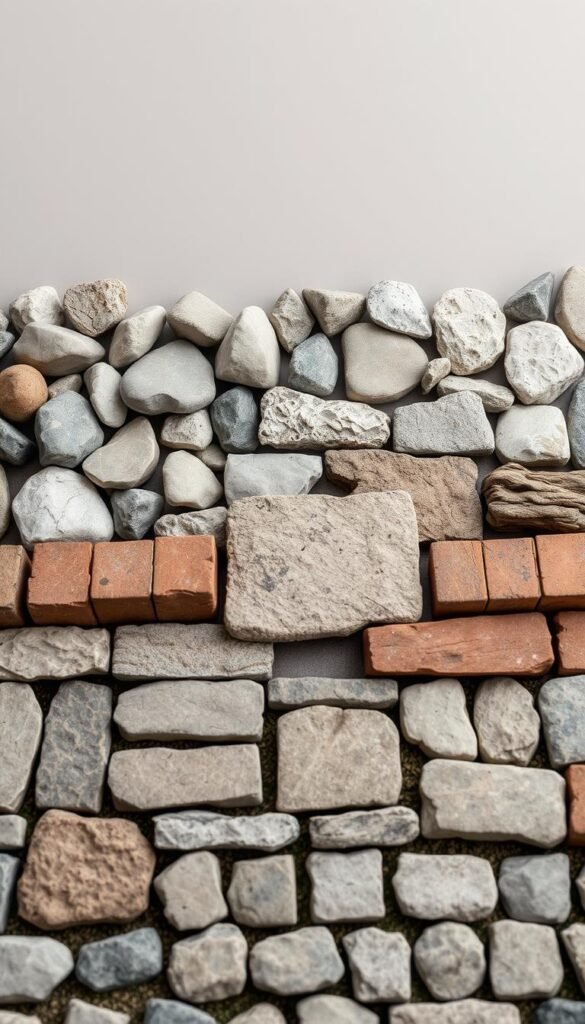
The materials you choose shape both beauty and function in your landscape. From rustic charm to modern minimalism, every option brings unique strengths. Consider your budget, local climate, and desired maintenance level when exploring possibilities.
Natural Stone vs. Manufactured Options
Natural stone like limestone or river rock offers organic textures that age gracefully. One landscaper notes: “Each piece tells a story through its imperfections—perfect for creating that ‘lived-in’ look.” These materials blend seamlessly with cottage gardens or woodland settings.
Manufactured choices like concrete pavers provide precision for contemporary designs. Their uniform shapes make installation faster, and many options mimic natural materials at lower costs. Check out this comparison:
| Material Type | Best For | Cost Range | Maintenance |
|---|---|---|---|
| Fieldstone | Rustic pathways | $$$ | Low |
| Concrete Blocks | Modern borders | $$ | Moderate |
| Recycled Brick | Traditional edging | $ | Minimal |
Matching Materials with Your Garden’s Style
Your home’s architecture should guide material selection. A craftsman bungalow pairs well with stacked stone, while mid-century modern homes shine with geometric concrete. For DIY garden art projects, combine leftover materials creatively.
Consider long-term performance. In freeze-thaw zones, choose frost-resistant options. Coastal areas need salt-tolerant materials. Always balance style with practicality—your hardscaping should look good decades from now, not just next spring.
Transforming Your Front Yard Flower Garden with Eye-Catching Hardscaping
Blending structural elements with vibrant blooms creates harmony in outdoor spaces. When done right, hardscape features become natural extensions of your plantings rather than competing distractions. The secret lies in balancing proportions and choosing materials that echo your home’s character.
Blending Built Elements with Nature
Start by matching the scale of your hardscaping to your space. A sprawling property can handle large stone walls, while compact areas shine with subtle brick edging. One landscaper suggests: “Use local materials whenever possible—they’ll weather beautifully and look like they’ve always been there.”
Consider these pairing strategies:
- Rough-cut sandstone alongside feathery astilbe
- Smooth concrete planters filled with bold canna lilies
- Recycled brick borders framing clusters of lavender
Designing with Drama and Purpose
Contrast adds excitement to your landscape. Try dark slate stepping stones through a carpet of bright creeping thyme. Retaining walls do double duty—they tame slopes while creating elevated stages for showy peonies or dwarf conifers.
Pathways deserve special attention. Curved gravel walks invite exploration, while straight flagstone routes deliver clean lines. Pro tip: Widen paths near seating areas to create natural gathering spots surrounded by blossoms.
Through thoughtful combinations, your structural elements will highlight floral displays in spring and provide sculptural interest when gardens rest. That’s how you craft spaces that captivate in every season.
Utilizing Water Features as Dynamic Focal Points
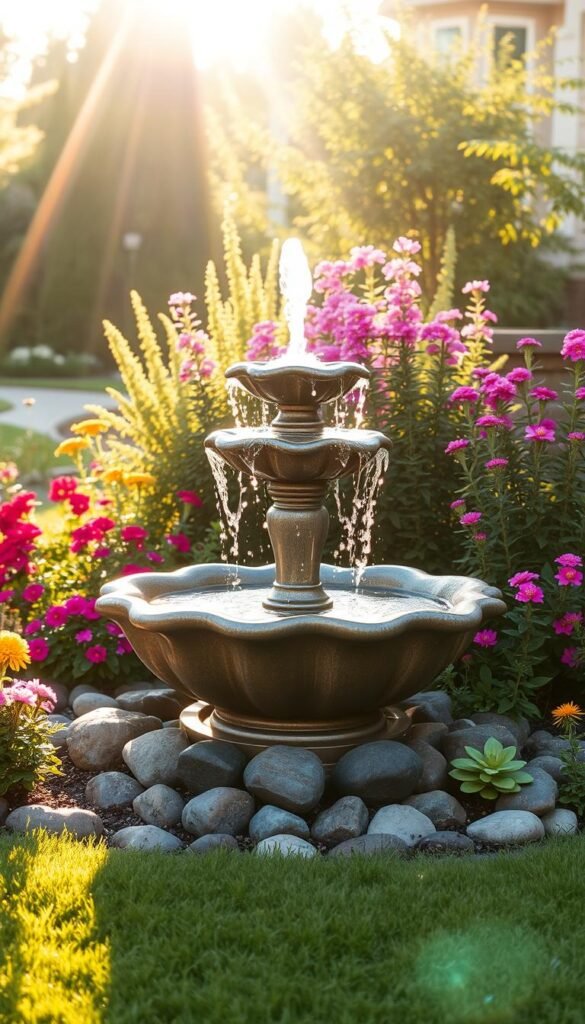
The gentle murmur of moving water adds instant magic to any outdoor space. A well-placed water feature becomes more than decoration—it’s a living element that engages sight, sound, and touch. Solar-powered options now make these installations accessible without complex wiring.
Fountains, Ponds, and Solar Power Options
Modern solar pumps let you place fountains anywhere sunlight reaches. One homeowner raved: “Our solar birdbath fountain runs all day—no cords, just cheerful splashing!” These systems store energy in batteries, keeping water flowing into the evening.
Consider these factors when choosing:
| Feature Type | Best Location | Maintenance |
|---|---|---|
| Tiered Fountain | Center of circular beds | Weekly cleaning |
| Reflecting Pond | Near seating areas | Seasonal algae control |
| Bubbling Urn | Entryway accents | Monthly pump checks |
Position your focal point where it’s visible from key areas—like near porch steps. The sound masks street noise while attracting hummingbirds and dragonflies. Dark stone basins make water reflections pop, doubling your blooms’ visual impact.
Solar technology keeps costs low. No electrician needed—just place the panel in sun. This charm comes with practicality: many models automatically shut off when water levels drop, protecting pumps.
Incorporating Various Types of Flower Beds
Choosing the right style for your outdoor space depends on both aesthetics and practicality. Each bed type solves unique challenges while adding personality to your landscape. Let’s explore options that balance beauty with smart functionality.
Raised & Border Solutions
Raised beds give you control over soil quality and drainage—perfect for clay-heavy areas. Their elevated design reduces back strain during planting. One gardener shared: “My tomato harvest doubled after switching to raised beds with custom soil mixes.”
Border beds define spaces naturally. Use them along fences or walkways with layered plants. Combine flowering perennials with evergreen shrubs for structure. This approach keeps edges tidy while supporting pollinators.
Island & Natural Designs
Island beds break up lawn monotony. Position them as focal points surrounded by mulch or gravel. These standalone features allow 360-degree viewing—ideal for showcasing bold flowers like dahlias or sunflowers.
Natural arrangements mimic wild growth patterns. Cluster plants in irregular groups with varying heights. This low-maintenance style uses native species that thrive in local conditions. The result? A garden that looks effortlessly established.
Whether you prefer structured borders or free-flowing cottage beds, match your choice to maintenance habits and space constraints. The right mix creates visual harmony while supporting healthy plant growth.
Enhancing Curb Appeal with Native Plants
Boosting your home’s first impression starts with nature’s own solutions. Native plants thrive in local climates, requiring less water and minimal care compared to exotic species. Their deep roots prevent soil erosion, while their blooms feed bees and butterflies—a win for your landscape and local ecosystems.
Why fight nature? Black-eyed Susans and coneflowers flourish without synthetic fertilizers. Wild indigo adds striking purple spikes to beds while fixing nitrogen in the soil. These hardy plants stay vibrant through droughts and downpours, keeping your yard photo-ready year-round.
For a whimsical touch, pair native species with cottagecore-inspired designs. Imagine pathways edged with fluffy milkweed or stone benches framed by feathery grasses. This approach blends sustainability with charm, creating a landscape that feels both intentional and wild.
Less work means more enjoyment. Swap high-maintenance lawns for clover or sedge meadows. You’ll save weekends once spent mowing—and gain front-row seats to nature’s daily show. Now that’s smart curb appeal.

